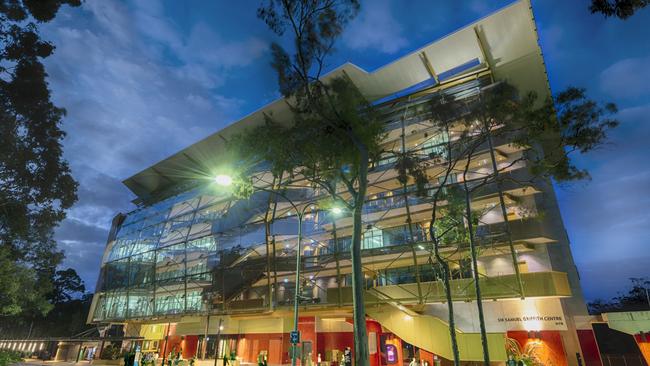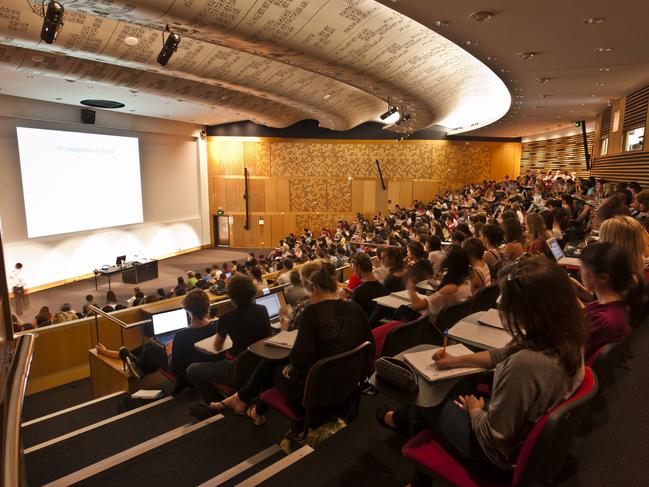Class divide: how students pay for universities’ vanity
Institutions splurge on branding and top staff, sapping resources from their core purpose.

Ivory towers and a doomsday documentary starring academics are just two of the vanity projects funded by universities at the same time they slashed staff, crying pandemic poverty.
Like elite private schools, universities are trying to lure high-paying students with flash five-star facilities and slick marketing.
As students bemoan a decline in teaching quality and overworked staff complain they are at “breaking point’’, most universities continue to invest in expensive real estate and pay for self-promotion.
Expenditure on marketing, executive salaries and property developments are sapping resources from the core purpose of a university – to educate and inspire students, and lead research in the national interest.

Griffith University is planning to build a 55-storey ivory tower in Brisbane’s CBD, as part of a $1bn budget to relocate its suburban campus to the heart of Brisbane’s CBD – competing directly against the long-established campus of the Queensland University of Technology.
QUT, in turn, spent $94m on a new building for its teaching degrees in 2019 – featuring a glorified digital display board known as The Sphere, a 3.5-tonne LED globe suspended over two floors.
Monash University is refusing to reveal how much it spent on a self-promoting documentary, to premiere at the Melbourne International Film Festival next month. The Endangered Generation? is narrated by Hollywood actor Laura Dern, best known for her role in the dinosaur adventure series Jurassic Park.
Featuring Monash academics, the documentary “captures the contributions of artists, activists and community leaders rising up to tackle the biggest challenges the human species faces today’’ – climate change, social inequality and species extinction.
“The amount Monash contributed towards the documentary is commercial in confidence,’’ a university spokeswoman told Inquirer, noting that partners included Screen Australia, VicScreen and the South Australian Film Corporation.
The doomsday documentary was part of the $19.1m Monash splurged on marketing and promotion last year – an 18 per cent increase from 2020.
Vice-chancellor Margaret Gardner earned $1.2m – twice as much as the Prime Minister – while 17 other executives were paid more than $400,000. At the same time, the university slashed $44m from staffing costs, and apologised for six years of wage theft that requires backpaying $8.6m to casual staff.
Half the nation’s universities have been underpaying their staff, a Senate inquiry concluded in March, and the Fair Work Ombudsman has targeted 17 institutions for wage theft investigations this year. Melbourne University, which made a $584m operating profit surplus and paid its vice-chancellor $1.45m last year, has paid back nearly $10m to more than 1000 casual academic staff.
The university even used gift cards to pay some casual staff, the Senate inquiry revealed.
“I can’t pay rent, pay for transport or pay for medical bills with gift cards,’’ creative writing tutor Hayley Singer told the inquiry. “Senior academics pushed back against this, too, but still it went ahead.’’

A University of Melbourne spokeswoman told Inquirer it was “currently working to identify all current and past practices that are inconsistent with our obligations and doing everything we can to make full remediation and ensure we fully comply with our obligations. We apologise to any staff member who may have been affected.”
The National Tertiary Education Union is furious that vice-chancellors pocketed an average salary of $1m while they sacked 8 per cent of tertiary staff during the pandemic.
“University vice-chancellor and executive wages are obscene,’’ says union president Alison Barnes. “They are public institutions, yet the universities have business models that are premised on casualisation and wage theft. Universities need to prioritise staff and students.”
As border closures robbed universities of full-fee-paying foreign students, 29,000 full-time equivalent jobs were lost during the pandemic, federal Education Department data shows. Barnes warns that staff cuts and casualisation of academic workers have left staff at “breaking point’’, eroding the quality of teaching.
National Union of Students president Georgie Beatty is concerned that the “commercialisation of universities’’ means students are treated as consumers at best, or a commodity at worst.
“Most vice-chancellors are paid more than the Prime Minister and that’s a spit in the face for students struggling with the cost of living while the quality of education is going down,’’ she told Inquirer.

A common bugbear among students is universities’ continued reliance on online tutorials, despite the return to campus after the Covid-19 emergency triggered lockdowns throughout 2020.
“Recently I had a class with 40 other students in my Zoom class with one casual tutor,’’ says Beatty. “How is that a good-quality education?’’
NUS education officer Luc Velez has calculated that some universities have higher rates of casual staff than fast-food giant McDonald’s.
“A lot of universities have seen class sizes increase dramatically,’’ he says. “My (law) class went from 30 people to 44 people during the pandemic and they kept the class size now that we’re back face to face. We don’t have time to discuss things in class or explore ideas, and that process is so essential for learning, especially in the humanities and law. It just can’t happen in bigger classes.’’

While convenient for students to juggle work and study, some online courses are out-of-date and of questionable quality that Velez describes as “glorified YouTube videos’’. “There’s a big push for online learning, but I want to be in a lecture theatre so I can chuck up my hand and ask questions, or go up to the lecturer after class,’’ he says. “I want interpersonal connection.’’
At QUT, law students have been taught using recorded lectures featuring an esteemed academic who had died suddenly. The university failed to inform students for months, updating the material only after complaints from the student guild.
“Leaving school all bright-eyed and bushy-tailed and finding out you’re learning from pre-recorded lessons is pretty disheartening,’’ QUT Student Guild president Oscar Davison told Inquirer.
“Students have spent all this money and put themselves into debt for their future, and find out in some instances they are not even learning from live recordings, and sometimes they were recorded in the past three years. Some of them included recordings of lectures and tutorials from a teacher who was deceased.’’
QUT pro vice-chancellor for digital learning Kevin Ashford-Rowe blames the delay on the late lecturer’s use of Second Life, a virtual hangout and lecturing space that other academics could not access.
“When he sadly passed away we suddenly found we were confronted with content on a system that we could not support and no one had knowledge of how it worked,’’ he told Inquirer. “In the normal course of events if something like that happened suddenly, we would be able to jump in and use the system.’’
Ashford-Rowe says online learning is here to stay, as students have become accustomed to the convenience of listening to lectures on demand, especially among the growing cohort of mature-aged students studying part-time while they work.
“You can come off your shift or out of a nightclub at 3 o’clock in the morning (and study online),’’ he says. “Our students have learned to expect information will be available at a time and a place they choose’’.
Velez is studying law, philosophy and economics at the University of NSW, which increased its marketing expenditure by 25 per cent to $10m last year.
He insists that students would sooner see money spent on quality teaching than flash facilities and slick self-promotion. “There is so much money going into brand image,” he says. “The best marketing would be to offer a better learning experience.’’








To join the conversation, please log in. Don't have an account? Register
Join the conversation, you are commenting as Logout